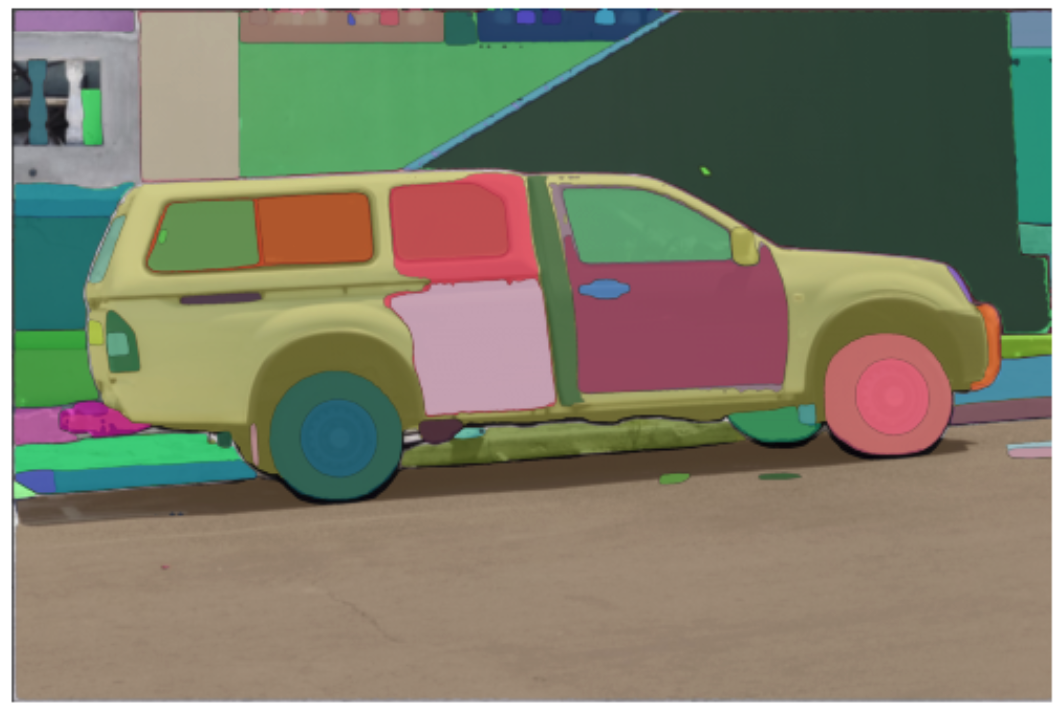# SAM
## Overview
SAM (Segment Anything Model) was proposed in [Segment Anything](https://arxiv.org/pdf/2304.02643v1.pdf) by Alexander Kirillov, Eric Mintun, Nikhila Ravi, Hanzi Mao, Chloe Rolland, Laura Gustafson, Tete Xiao, Spencer Whitehead, Alex Berg, Wan-Yen Lo, Piotr Dollar, Ross Girshick.
The model can be used to predict segmentation masks of any object of interest given an input image.

The abstract from the paper is the following:
*We introduce the Segment Anything (SA) project: a new task, model, and dataset for image segmentation. Using our efficient model in a data collection loop, we built the largest segmentation dataset to date (by far), with over 1 billion masks on 11M licensed and privacy respecting images. The model is designed and trained to be promptable, so it can transfer zero-shot to new image distributions and tasks. We evaluate its capabilities on numerous tasks and find that its zero-shot performance is impressive -- often competitive with or even superior to prior fully supervised results. We are releasing the Segment Anything Model (SAM) and corresponding dataset (SA-1B) of 1B masks and 11M images at [https://segment-anything.com](https://segment-anything.com) to foster research into foundation models for computer vision.*
Tips:
- The model predicts binary masks that states the presence or not of the object of interest given an image.
- The model predicts much better results if input 2D points and/or input bounding boxes are provided
- You can prompt multiple points for the same image, and predict a single mask.
- Fine-tuning the model is not supported yet
- According to the paper, textual input should be also supported. However, at this time of writing this seems to be not supported according to [the official repository](https://github.com/facebookresearch/segment-anything/issues/4#issuecomment-1497626844).
This model was contributed by [ybelkada](https://huggingface.co/ybelkada) and [ArthurZ](https://huggingface.co/ArthurZ).
The original code can be found [here](https://github.com/facebookresearch/segment-anything).
Below is an example on how to run mask generation given an image and a 2D point:
```python
import torch
from PIL import Image
import requests
from transformers import SamModel, SamProcessor
device = "cuda" if torch.cuda.is_available() else "cpu"
model = SamModel.from_pretrained("facebook/sam-vit-huge").to(device)
processor = SamProcessor.from_pretrained("facebook/sam-vit-huge")
img_url = "https://huggingface.co/ybelkada/segment-anything/resolve/main/assets/car.png"
raw_image = Image.open(requests.get(img_url, stream=True).raw).convert("RGB")
input_points = [[[450, 600]]] # 2D location of a window in the image
inputs = processor(raw_image, input_points=input_points, return_tensors="pt").to(device)
with torch.no_grad():
outputs = model(**inputs)
masks = processor.image_processor.post_process_masks(
outputs.pred_masks.cpu(), inputs["original_sizes"].cpu(), inputs["reshaped_input_sizes"].cpu()
)
scores = outputs.iou_scores
```
You can also process your own masks alongside the input images in the processor to be passed to the model.
```python
import torch
from PIL import Image
import requests
from transformers import SamModel, SamProcessor
device = "cuda" if torch.cuda.is_available() else "cpu"
model = SamModel.from_pretrained("facebook/sam-vit-huge").to(device)
processor = SamProcessor.from_pretrained("facebook/sam-vit-huge")
img_url = "https://huggingface.co/ybelkada/segment-anything/resolve/main/assets/car.png"
raw_image = Image.open(requests.get(img_url, stream=True).raw).convert("RGB")
mask_url = "https://huggingface.co/ybelkada/segment-anything/resolve/main/assets/car.png"
segmentation_map = Image.open(requests.get(mask_url, stream=True).raw).convert("1")
input_points = [[[450, 600]]] # 2D location of a window in the image
inputs = processor(raw_image, input_points=input_points, segmentation_maps=segmentation_map, return_tensors="pt").to(device)
with torch.no_grad():
outputs = model(**inputs)
masks = processor.image_processor.post_process_masks(
outputs.pred_masks.cpu(), inputs["original_sizes"].cpu(), inputs["reshaped_input_sizes"].cpu()
)
scores = outputs.iou_scores
```
## Resources
A list of official Hugging Face and community (indicated by 🌎) resources to help you get started with SAM.
- [Demo notebook](https://github.com/huggingface/notebooks/blob/main/examples/segment_anything.ipynb) for using the model.
- [Demo notebook](https://github.com/huggingface/notebooks/blob/main/examples/automatic_mask_generation.ipynb) for using the automatic mask generation pipeline.
- [Demo notebook](https://github.com/NielsRogge/Transformers-Tutorials/blob/master/SAM/Run_inference_with_MedSAM_using_HuggingFace_Transformers.ipynb) for inference with MedSAM, a fine-tuned version of SAM on the medical domain. 🌎
- [Demo notebook](https://github.com/NielsRogge/Transformers-Tutorials/blob/master/SAM/Fine_tune_SAM_(segment_anything)_on_a_custom_dataset.ipynb) for fine-tuning the model on custom data. 🌎
## SlimSAM
SlimSAM, a pruned version of SAM, was proposed in [0.1% Data Makes Segment Anything Slim](https://arxiv.org/abs/2312.05284) by Zigeng Chen et al. SlimSAM reduces the size of the SAM models considerably while maintaining the same performance.
Checkpoints can be found on the [hub](https://huggingface.co/models?other=slimsam), and they can be used as a drop-in replacement of SAM.
## Grounded SAM
One can combine [Grounding DINO](grounding-dino) with SAM for text-based mask generation as introduced in [Grounded SAM: Assembling Open-World Models for Diverse Visual Tasks](https://arxiv.org/abs/2401.14159). You can refer to this [demo notebook](https://github.com/NielsRogge/Transformers-Tutorials/blob/master/Grounding%20DINO/GroundingDINO_with_Segment_Anything.ipynb) 🌍 for details.
 Grounded SAM overview. Taken from the original repository.
## SamConfig
[[autodoc]] SamConfig
## SamVisionConfig
[[autodoc]] SamVisionConfig
## SamMaskDecoderConfig
[[autodoc]] SamMaskDecoderConfig
## SamPromptEncoderConfig
[[autodoc]] SamPromptEncoderConfig
## SamProcessor
[[autodoc]] SamProcessor
## SamImageProcessor
[[autodoc]] SamImageProcessor
## SamModel
[[autodoc]] SamModel
- forward
## TFSamModel
[[autodoc]] TFSamModel
- call
Grounded SAM overview. Taken from the original repository.
## SamConfig
[[autodoc]] SamConfig
## SamVisionConfig
[[autodoc]] SamVisionConfig
## SamMaskDecoderConfig
[[autodoc]] SamMaskDecoderConfig
## SamPromptEncoderConfig
[[autodoc]] SamPromptEncoderConfig
## SamProcessor
[[autodoc]] SamProcessor
## SamImageProcessor
[[autodoc]] SamImageProcessor
## SamModel
[[autodoc]] SamModel
- forward
## TFSamModel
[[autodoc]] TFSamModel
- call
 Grounded SAM overview. Taken from the original repository.
## SamConfig
[[autodoc]] SamConfig
## SamVisionConfig
[[autodoc]] SamVisionConfig
## SamMaskDecoderConfig
[[autodoc]] SamMaskDecoderConfig
## SamPromptEncoderConfig
[[autodoc]] SamPromptEncoderConfig
## SamProcessor
[[autodoc]] SamProcessor
## SamImageProcessor
[[autodoc]] SamImageProcessor
## SamModel
[[autodoc]] SamModel
- forward
## TFSamModel
[[autodoc]] TFSamModel
- call
Grounded SAM overview. Taken from the original repository.
## SamConfig
[[autodoc]] SamConfig
## SamVisionConfig
[[autodoc]] SamVisionConfig
## SamMaskDecoderConfig
[[autodoc]] SamMaskDecoderConfig
## SamPromptEncoderConfig
[[autodoc]] SamPromptEncoderConfig
## SamProcessor
[[autodoc]] SamProcessor
## SamImageProcessor
[[autodoc]] SamImageProcessor
## SamModel
[[autodoc]] SamModel
- forward
## TFSamModel
[[autodoc]] TFSamModel
- call